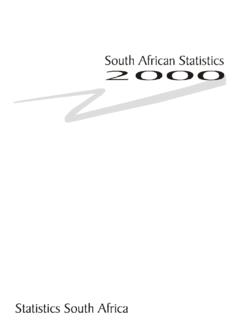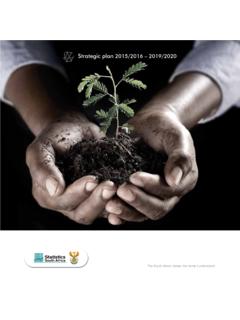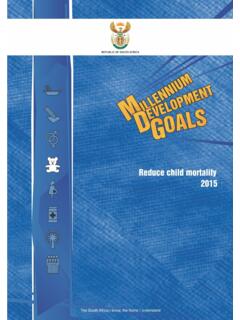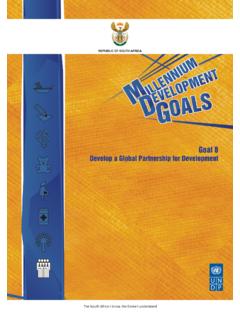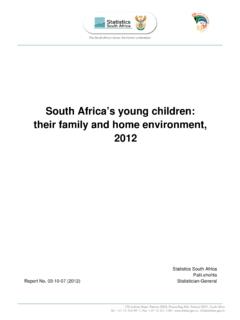Transcription of STATISTICAL RELEASE P0302 - Statistics South Africa
1 Private Bag X44, Pretoria, 0001, South Africa , ISIbalo House, Koch Street, Salvokop, Pretoria, 0002 , Tel +27 12 310 8911 STATISTICAL RELEASE P0302 Mid-year population estimates 2019 Embargoed until: 29 July 2019 10:00 ENQUIRIES: FORTHCOMING ISSUE: EXPECTED RELEASE DATE User Information Services 2020 31 July 2020 Tel:(012)310 8600/4892/8390 Statistics South Africa P0302 Mid-year population estimates, 2019 ii Contents Acronyms and abbreviations .. iv Summary .. v 1. Introduction .. 1 2. Demographic and other assumptions .. 1 3. Demographic and other indicators .. 3 4. National population estimates .. 8 5. Provincial population estimates .. 11 Demographic assumptions .. 11 Migration patterns .. 14 Provincial distributions .. 16 References .. 20 Appendices .. 21 List of tables Table 1: Mid-year population estimates for South Africa by population group and sex, 2019.
2 Vi Table 2: Assumptions of expectation of life at birth without HIV/AIDS and total fertility rate, 2002 2019 .. 2 Table 3: International net-migration assumptions for the period 1985 2021 .. 3 Table 4: Births and deaths for the period 2002 2019 .. 6 Table 5: Mid-year population estimates by population group and sex, 2019 .. 8 Table 6: Mid-year population estimates by population group, age and sex, 2019 .. 10 Table 7: Estimated provincial migration streams 2006 2011 .. 14 Table 8: Estimated provincial migration streams 2011 2016 .. 15 Table 9: Estimated provincial migration streams 2016 2021 .. 15 Table 10: Percentage distribution of the projected provincial share of the total population, 2002 2019 .. 16 Table 11 (a): Provincial mid-year population estimates by age and sex, 2019 .. 17 Table 11 (b): Provincial mid-year population estimates by age and sex, 2019 (concluded) .. 18 Statistics South Africa P0302 Mid-year population estimates, 2019 iii List of figures Figure 1: Mid-year population estimates for South Africa by province, 2019.
3 Vi Figure 2: Crude birth rate, crude death rate, and rate of natural increase over time, 2002 2019 .. 4 Figure 3: Life expectancy by sex over time, 2002 2019 .. 5 Figure 4: IMR, U5MR and CDR over time, 2002 2019 .. 5 Figure 5: HIV prevalence by selected age groups, 2002 2019 .. 7 Figure 6: HIV Population over time, 2002 2019 .. 7 Figure 7: Population growth rates by selected age groups over time, 2002 2019 .. 9 Figure 8: Provincial average total fertility rate over time, 2001 2021 .. 11 Figure 9: Provincial average total fertility rate, 2016 2021 .. 12 Figure 10: Provincial average life expectancy at birth (males) .. 17 Figure 11: Provincial average life expectancy at birth (females) .. 13 Figure 12: Population under 15 years of age .. 19 Figure 13: Proportion of elderly aged 60+ .. 19 Statistics South Africa P0302 Mid-year population estimates.
4 2019 iv Acronyms and abbreviations AIDS acquired immune deficiency syndrome AIM AIDS impact model ANC antenatal care ART antiretroviral therapy CBR crude birth rate CDR crude death rate DemProj Demographic projections HIV human immunodeficiency syndrome IMF International Monetary Fund IMR infant mortality rate IOM International Organisation for Migration NSO National STATISTICAL Organisation OECD The Organisation for Economic Co-operation and Development PMTCT prevention of mother-to-child transmission PLWHIV People living with HIV RAPID Rapid Mortality Surveillance RNI rate of natural increase SDDS Special Data Dissemination Standards Stats SA Statistics South Africa TFR total fertility rate U5MR under-five mortality rate Statistics South Africa P0302 Mid-year population estimates, 2019 v Summary The cohort-component methodology is used to estimate the 2019 mid-year population of South Africa .
5 The estimates cover all the residents of South Africa at 2019 mid-year point, and are based on the latest available information. Estimates may change as new data become available. The new estimates are accompanied by an entire series of revised estimates for the period 2002 2019. On this basis, comparisons between this model and previous ones should not be made. For 2019, Statistics South Africa (Stats SA) estimates the mid-year population at 58,78 million. Approximately 51,2% (approximately 30 million) of the population is female. Gauteng comprises the largest share of the South African population, with approximately 15,2 million people (25,8%) living in this province. KwaZulu- natal is the province with the second largest population, with an estimated 11,3 million people (19,2%) living in this province. With a population of approximately 1,26 million people (2,2%), Northern Cape remains the province with the smallest share of the South African population.
6 About 28,8% of the population is aged younger than 15 years and approximately 9,0% (5,3 million) is 60 years or older. Of those younger than 15 years of age, the majority reside in Gauteng (21,5%) and KwaZulu- natal (21,1%). Of the elderly (those aged 60 years and older), the highest percentage 23,9% (1,27 million) reside in Gauteng. The proportion of elderly persons aged 60 and older is increasing over time. Migration is an important demographic process, as it shapes the age structure and distribution of the provincial population. For the period 2016 2021, Gauteng and Western Cape are estimated to experience the largest inflow of migrants of approximately, 1 643 590 and 493 621 respectively (see migration stream Tables 7, 8 and 9 for net migration). Life expectancy at birth for 2019 is estimated at 61,5 years for males and 67,7 years for females. The infant mortality rate for 2019 is estimated at 22,1 per 1 000 live births.
7 The estimated overall HIV prevalence rate is approximately 13,5% among the South African population. The total number of people living with HIV (PLWHIV) is estimated at approximately 7,97 million in 2019. For adults aged 15 49 years, an estimated 19,07% of the population is HIV positive. Statistics South Africa P0302 Mid-year population estimates, 2019 vi Table 1: Mid-year population estimates for South Africa by population group and sex, 2019 Population group Male Female Total Number % distribution of males Number % distribution of females Number % distribution of total Black African 23 124 782 80,7 24 318 477 80,8 47 443 259 80,7 Coloured 2 513 221 8,8 2 663 530 8,8 5 176 750 8,8 Indian/Asian 768 594 2,7 734 413 2,4 1 503 007 2,6 White 2 266 151 7,9 2 385 855 7,9 4 652 006 7,9 Total 28 672 747 100,0 30 102 275 100,0 58 775 022 100,0 Figure 1.
8 Mid-year population estimates for South Africa by province, 2019 Risenga Maluleke Statistician-General 1263875288746540271604592187598258467122 766844272112890861517611502 000 0004 000 0006 000 0008 000 00010 000 00012 000 00014 000 00016 000 000 Northern CapeFree StateNorth WestMpumalangaLimpopoEastern CapeWestern CapeKwaZulu-NatalGautengSTATISTICS South Africa P0302 Mid-year population estimates, 2019 1 1. Introduction In a projection, the size and composition of the future population of an entity such as South Africa is estimated. The mid-year population estimates produced by Statistics South Africa (Stats SA) uses the cohort-component method for population estimation. In the cohort-component method, a base population is estimated that is consistent with known demographic characteristics of the country. The cohort base population is projected into the future according to the projected components of change.
9 Selected levels of fertility, mortality and migration are used as input to the cohort-component method. For the 2019 mid-year estimates, the cohort-component method is utilised within the Spectrum Policy Modelling system. Spectrum is a Windows-based system of integrated policy models (version ). The DemProj module within Spectrum is used to develop the demographic projection, whilst the AIDS Impact Model (AIM) is used to incorporate the impacts of HIV and AIDS on fertility and mortality, and ultimately the population estimates. Stats SA subscribes to the specifications of the Special Data Dissemination Standards (SDDS) of the International Monetary Fund (IMF). This standard is related to the dissemination of this report which dictates that it should be released within one month of the mid-year. The mid-year estimates are an estimate of the population as at 01 July in a given year.
10 The estimates of stock such as population size, number infected with HIV etc. pertain to the middle of the year 01 July, whilst the estimates of flow births, deaths, Total Fertility Rates (TFRs), Infant Mortality Rates (IMRs) etc. are for a 12-month period 01 July 2019 to 30th June 2020. A stock variable is measured at a given time, and represents a quantity at each moment in time the number of population at a certain moment whilst an estimate of flow is typically measured over a certain interval of time. The mid-year population estimates are published annually. It is misleading to compare values and rankings with those of previously published reports, due to revisions and updates of the underlying data and adjustments. Users are advised to use the complete series published along with this report on the Stats SA website. 2. Demographic and other assumptions A cohort-component projection requires a base population distributed by age and sex.
